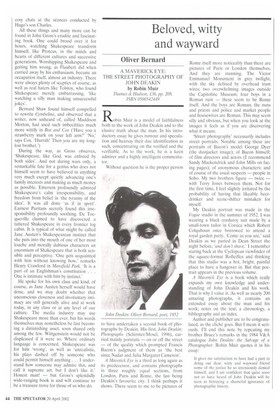Beloved, witty and wayward
Oliver Bernard
A MAVERICK EYE: THE STREET PHOTOGRAPHY OF JOHN DEAKIN by Robin Muir Thames & Hudson, £36, pp. 208, ISBN 0500542449 Robin Muir is a model of faithfulness both to the work of John Deakin and to the elusive truth about the man. In his introductory essay he gives rumour and speculation and hearsay their due identification as such, concentrating on the verified and the verifiable. As to the work, he is a keen admirer and a highly intelligent commentator.
Without question he is the proper person to have undertaken a second book of photographs by Deakin. His first, John Deakin: Photographs (Schirmer/Mosel, 1996), carried mainly portraits — on or off the street — of the quality which prompted Francis Bacon's judgment of them as 'the best since Nadar and Julia Margaret Cameron'.
A Maverick Eye is a third as long again as its predecessor, and contains photographs in three roughly equal sections, from London, Paris and Rome, the last being Deakin's favourite city. I think perhaps it shows. There seem to me to be pictures of Rome itself more noticeably than there are pictures of Paris or London themselves. And they are stunning. The Victor Emmanuel Monument in grey twilight, with the sky defined by overhead tram wires; two overwhelming images outside the Capitoline Museum; four boys in a Roman ruin — these seem to be Rome itself. And the boys are Roman, the nuns and priests and police and market people and housewives are Roman. This may seem silly and obvious, but when you look at the images it feels as if you arc discovering what it means.
'Street photography' necessarily includes street portraits. Notable among these are portraits of Bacon's model George Dyer (the dustjacket image); of Bacon himself; of film directors and actors (I recommend Sandy Mackendrick and John Mills on facing pages); of anonymous characters: and of course of the usual suspects — people in Soho. My two brothers figure — twice — with Terry Jones between them. Not for the first time, I feel slightly irritated by the probability of having that likeable beerdrinker and scene-shifter mistaken for myself.
My Deakin portrait was made in the Vogue studio in the summer of 1952. I was wearing a black corduroy suit made by a small-town tailor in Corsica which Robert Colquhoun once borrowed to attend a royal garden party. 'Come as you are,' said Deakin as we parted in Dean Street the night before, 'and don't shave.' I remember staring back at the Cyclopean viewfinder of the square-format Rolleiflex and thinking that this studio was a hot, bright, painful place to have a hangover in. But that portrait appears in the previous volume.
A Maverick Eye is a book which really expands my own knowledge and understanding of John Deakin and his work. That is why I value it. As well as nearly 200 amazing photographs, it contains an extended essay about the man and his work; notes on the text; a chronology, a bibliography and an index.
Author and publisher are to be congratulated, as the cliché goes. But I mean it seriously. I'll end this note by repeating my brother Bruce's remarks in the 1984 V&A catalogue John Deakin: the Salvage of a Photographer. Robin Muir quotes it in his essay:
It gives mc satisfaction to have had a part in doing our dear, witty and wayward friend some of the justice he so strenuously denied himself, and I am confident that quite soon not to have heard of John Deakin will be seen as betraying a shameful ignorance of photographic history.






































































 Previous page
Previous page